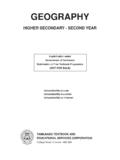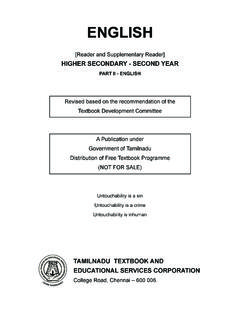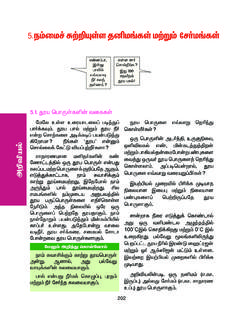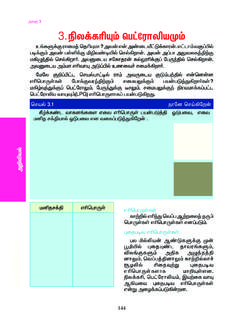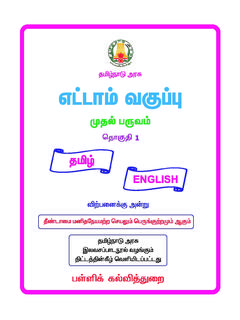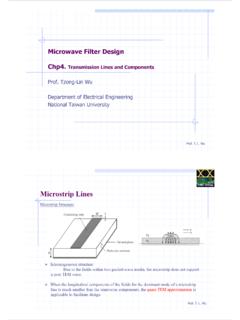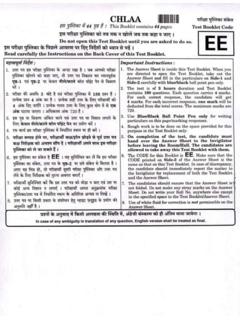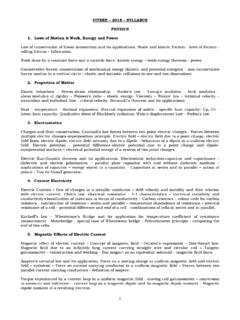Transcription of PHYSICS - Textbooks Online
1 PHYSICSHIGHER SECONDARYSECOND YEARVOLUME - ITAMILNADU TEXTBOOKCORPORATIONCOLLEGE ROAD, CHENNAI - 600 006 Untouchability is a sinUntouchability is a crimeUntouchability is inhumanRevised based on the recommendation of theTextbook Development CommitteeReviewersP. SARVAJANA RAJANS election Grade Lecturer in CollegeNandanam, Chennai - 600 035S. KEMASARIS election Grade Lecturer in PhysicsQueen Mary s College (Autonomous)Chennai - 600 004Dr. K. MANIMEGALAIR eader in PhysicsThe Ethiraj College for WomenChennai - 600 008G. SANKARIS election Grade Lecturer in PhysicsMeenakshi College for WomenKodambakkam, Chennai - 600 024G.
2 ANBALAGANL ecturer in PhysicsAringnar Anna Govt. Arts PONNUSAMYAsst. Professor of Engineering Institute of Science and Technology(Deemed University)Kattankulathur - 603 203S. Assistant in PhysicsGovt. Hr. Sec. SchoolKodambakkam, Chennai - 600 024 GIRIJA Assistant in PhysicsGovt. Girls Hr. Sec. SchoolAshok Nagar, Chennai - 600 083P. Assistant in PhysicsGovt. Girls Hr. Sec. SchoolTiruchengode - 637 211 Namakkal DistrictDr. N. VIJAYANP rincipalZion Matric Hr. Sec. SchoolSelaiyurChennai - 600 073Dr. HEMAMALINI RAJAGOPALS enior Scale Lecturer in PhysicsQueen Mary s College (Autonomous)Chennai - 600 004 CHAIRPERSONDr.
3 S. GUNASEKARANR eaderPost Graduate and Research Department of PhysicsPachaiyappa s College, Chennai - 600 030c Government of TamilnaduFirst edition - 2005 Revised edition - 2007 This book has been printed on 60 paperPrice : book has been prepared by the Directorate of School Education on behalf ofthe Government of TamilnaduPrinted by of fset at :IIIP refaceThe most important and crucial stage of school education is thehigher secondary level. This is the transition level from a generalisedcurriculum to a discipline-based order to pursue their career in basic sciences and professionalcourses, students take up PHYSICS as one of the subjects.
4 To providethem sufficient background to meet the challenges of academic andprofessional streams, the PHYSICS textbook for Std. XII has been reformed,updated and designed to include basic information on all chapter starts with an introduction, followed by subject the topics are presented with clear and concise treatments. Thechapters end with solved problems and self evaluation the concepts is more important than it is intended to make the students understand the subjectthoroughly so that they can put forth their ideas clearly. In order tomake the learning of PHYSICS more interesting, application of concepts inreal life situations are presented in this importance has been given to develop in the students,experimental and observation skills.
5 Their learning experience wouldmake them to appreciate the role of PHYSICS towards the improvementof our following are the salient features of the text data has been systematically are neatly questions (only samples) are included to sharpenthe reasoning ability of the preparing for the examination, students should notrestrict themselves, only to the questions/problems given in the selfevaluation. They must be prepared to answer the questions andproblems from the text/syllabus. Dr. S. GunasekaranChairpersonIVSYLLABUS (180 periods)UNIT 1 ELECTROSTATICS (18 periods)Frictional electricity, charges and their conservation; Coulomb slaw forces between two point electric charges.
6 Forces betweenmultiple electric charges superposition field Electric field due to a point charge, electric fieldlines; Electric dipole, electric field intensity due to a dipole behaviorof dipole in a uniform electric field application of electric dipole inmicrowave potential potential difference electric potential due toa point charge and due a dipole. Equipotential surfaces Electricalpotential energy of a system of two point flux Gauss s theorem and its applications to find fielddue to (1) infinitely long straight wire (2) uniformly charged infiniteplane sheet (3) two parallel sheets and (4) uniformly charged thinspherical shell (inside and outside)Electrostatic induction capacitor and capacitance Dielectricand electric polarisation parallel plate capacitor with and withoutdielectric medium applications of capacitor energy stored in acapacitor.
7 Capacitors in series and in parallel action of points Lightning arrester Van de Graaff - 2 CURRENT ELECTRICITY (11 periods)Electric current flow of charges in a metallic conductor Driftvelocity and mobility and their relation with electric s law, electrical resistance. V-I characteristics Electricalresistivity and conductivity. Classification of materials in terms ofconductivity Superconductivity (elementary ideas) Carbon resistors colour code for carbon resistors Combination of resistors seriesand parallel Temperature dependence of resistance Internalresistance of a cell Potential difference and emf of a s law illustration by simple circuits Wheatstone sBridge and its application for temperature coefficient of resistancemeasurement Metrebridge Special case of Wheatstone bridge Potentiometer principle comparing the emf of two power Chemical effect of current Electro chemicalcells Primary (Voltaic.)
8 Lechlanche, Daniel) Secondary rechargeablecell lead acid 3 EFFECTS OF ELECTRIC CURRENT (15 periods)Heating effect. Joule s law Experimental effects Seebeck effect Peltier effect Thomsoneffect Thermocouple, thermoemf, neutral and inversiontemperature. effect of electric current Concept of magnetic field,Oersted s experiment Biot-Savart law Magnetic field due to aninfinitely long current carrying straight wire and circular coil Tangent galvanometer Construction and working Bar magnet as anequivalent solenoid magnetic field s circuital law and its on a moving charge in uniform magnetic field and electricfield cyclotron Force on current carrying conductor in a uniformmagnetic field.
9 Forces between two parallel current carrying conductors definition of experienced by a current loop in a uniform magneticfield-moving coil galvanometer Conversion to ammeter and voltmeter Current loop as a magnetic dipole and its magnetic dipole moment Magnetic dipole moment of a revolving 4 ELECTROMAGNETIC INDUCTION ANDALTERNATING CURRENT (14 periods)Electromagnetic induction Faraday s law induced emf andcurrent Lenz s induction Mutual induction Self inductance of a longsolenoid mutual inductance of two long of inducing emf (1) by changing magnetic induction(2) by changing area enclosed by the coil and (3) by changing theorientation of the coil (quantitative treatment) analytical treatmentcan also be generator commercial generator.
10 (Single phase, threephase).Eddy current Applications Transformer Long current measurement of AC AC circuit withresistance AC circuit with inductor AC circuit with capacitor - LCRseries circuit Resonance and Q factor: power in AC 5 ELECTROMAGNETIC WAVES AND WAVE OPTICS(17 periods)Electromagnetic waves and their characteristics Electromagnetic spectrum, Radio, microwaves, Infra red, visible, ultraviolet X rays, gamma and Absorption spectrum Line, Band and continuousspectra Flourescence and of light Corpuscular Wave Electromagnetic andQuantum of light Rayleigh s scattering Tyndal scattering Raman effect Raman spectrum Blue colour of the sky and reddishappearance of the sun at sunrise and and Huygen s principle Reflection.
